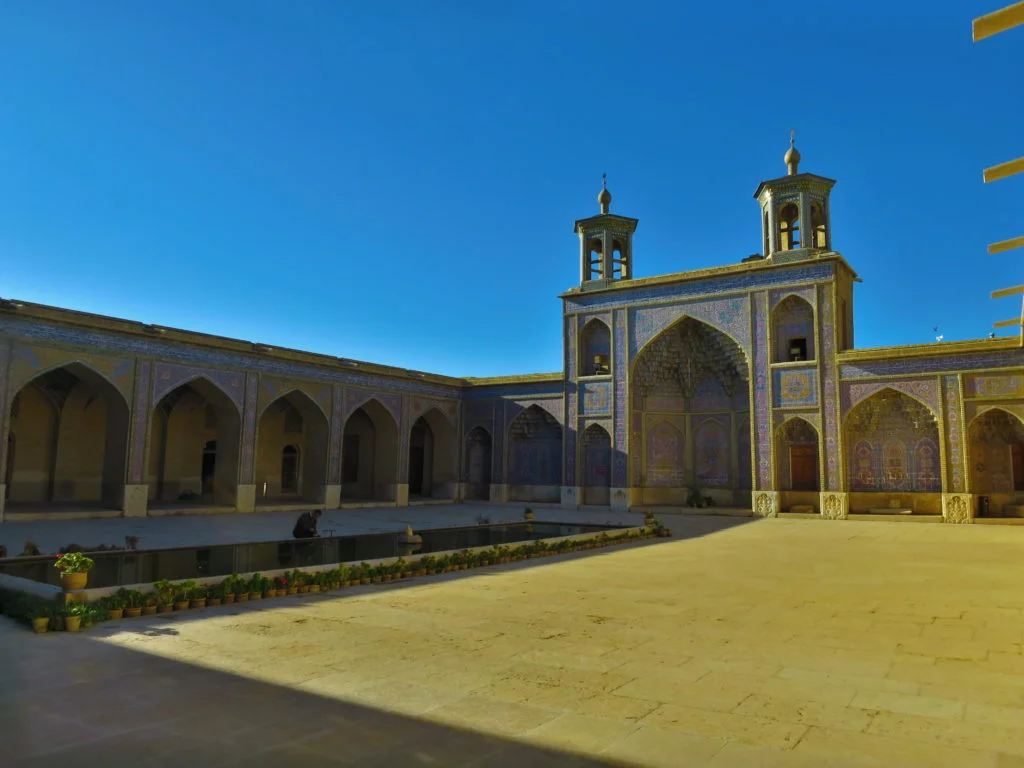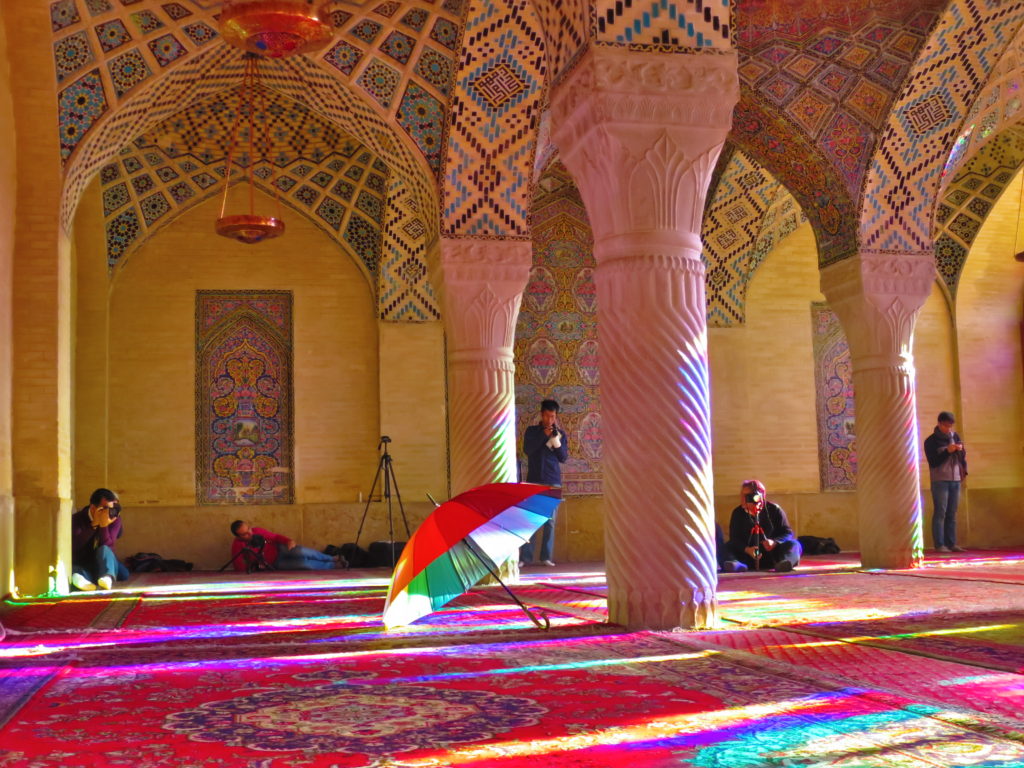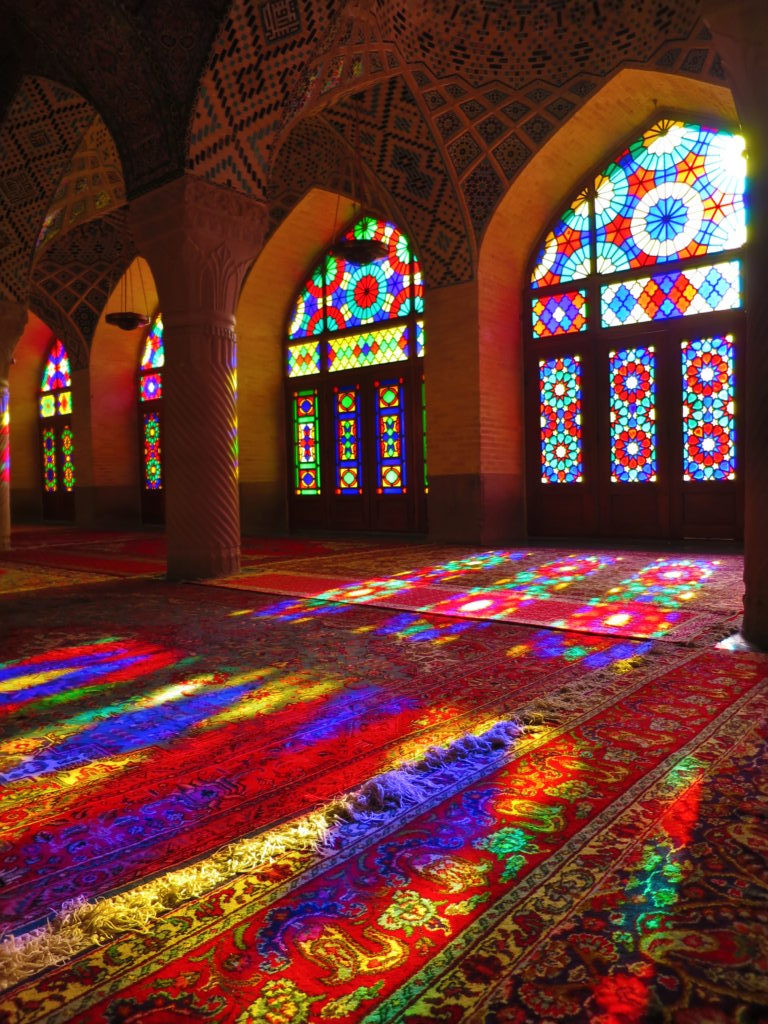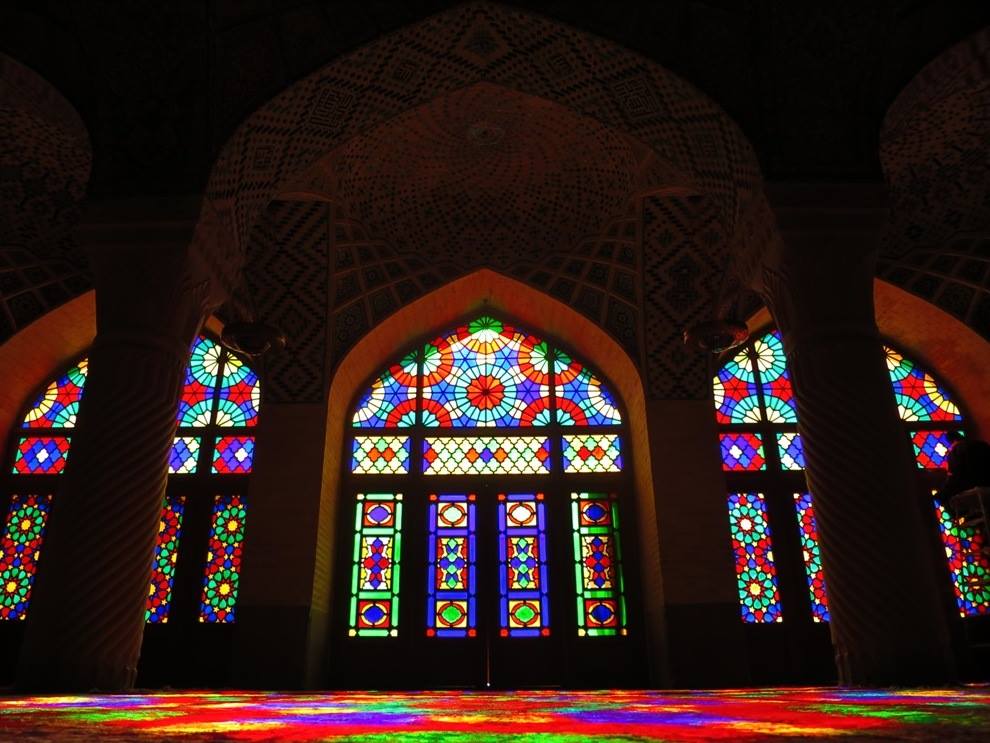The Stunning Stained Glass Light Show at Nasir ol-Molk / Nasir al-Mulk Mosque Iran
It seems an odd thing to do in Iran, but if you want to practice Japanese, Korean or Mandarin, head to the Nasir ol-Molk mosque, also known as Nasir al-Mulk mosque or the pink mosque in Shiraz. You’ll find the greatest concentration of East Asian tourists in Iran there. All of the visitors are there for one thing: a light show that is one of the most captivating that Man has made without electricity.
What is Nasir ol-Mulk, the mosque of whirling colors?
The Nasir al Mulk mosque in Shiraz was commissioned by the Mirza Hassan Ali, the wealthy son of a Qajar-era kelantar or mayor of the city. Construction lasted from 1876 to 1888. The mosque was intended as a burial place for Mirza’s father, and Mirza, who was also known by his title Nasir ol-Molk, ended up being buried there too.
Every year, the Nasir al-Mulk mosque draws thousands of people to Shiraz to see its salmon-pink mosaics and stained-glass windows. There would undoubtedly be more were it not for the trade sanctions on Iran and inconveniences placed on those who choose to see the beautiful country for themselves.
Walking through Nasir al-Mulk mosque architecture
There are several pretty sights around the 140-year-old mosque: the twin minarets mirrored in the ablution pool, an illuminated ancient cow well on the southern side, and honeycomb vaults at both ends. Don’t try to look for the elegant Shirazi dome from here; it’s only visible from an alley to the east.
If you also visit Eram Garden, another popular tourist destination in Shiraz and a UNESCO World Heritage Site in Iran, and think you see similar themes, you’d be right. Mirza commissioned the same people to take charge of the pavilions there and the Nasir al Mulk mosque architecture.
None of this is relevant to the light show that everyone’s there to see, however.

Lights…
The prayer hall on the north side is separated from the courtyard by seven large stained-glass windows. Although the sight of the thick white curtains veiling these windows is ghastly from the outside, don’t try tugging on them or searching for the caretakers. Leave them alone and head inside, where everything looks heaps better.

The entire complex lies along an axis that points toward Mecca in Saudi Arabia. As such, at breakfast time each day, sunshine bathes the carpets and the fluted pillars in intense blue, red, yellow and pink hues. There’s no fuzzy logic at work in this kaleidoscope, just the movement of the earth controlling the light and a few thousand pieces of tinted glass taming it. Winter is the prettiest season because the low sun casts more colour everywhere inside–the walls, pillars and carpet are bathed in it.
The whole place lends itself to beautiful and creative photos, making it a magnet for camera-toting Asians. We lurve taking photographs, and there were more than a few Asians around when my friends and I dropped in.
Cameras…
Parts of the prayer hall were minefields of camera tripods during our visit, especially the area near the door. People were standing in the tinted light, letting it print polychromatic blossoms on their faces for their next Instagram post. Now and then, the clicks of camera shutters echoed off the pink-tiled walls and ceilings.

Thankfully, no loud tour groups were with us. While some of the poses the other visitors made weren’t appropriate for a place of worship (e.g. using Buddhist hand gestures), they generally kept the peace. This could change, of course, as Iran gets easier to visit with visas on arrival and word gets around. Maybe you should check it out before it happens.
I may have made things sound a lot worse than they actually were. Even though the early morning is the mosque’s most “crowded” period, we shared that space with no more than 20 other people. About half of them were Chinese, Japanese and Koreans travelling solo or in pairs. I hadn’t seen that many East Asians in one spot in Iran, yet none of the animosity between any of those countries on the global stage was apparent.
At Dolat Abad in Yazd, I was told that stained glass could keep mosquitoes out and improve one’s health; perhaps we should also test its calming properties.
Action.
It’s easy to lose track of the hours watching the ways people and surfaces interact with it. The sun continued its march across the sky unabated; the light slowly shortened and slipped off the pillars and the carpets.

The best time to visit Nasir ol-Molk / Nasir al-Mulk mosque in Shiraz Iran
Eventually, the shafts of light were at right angles to the windows. From the ceiling vault to the windows, to the illumination on the carpet, the symmetry was perfect. It was pure photography gold. All we wanted was to capture that fleeting moment of perfection in pixels.

We took turns to snap photographs from different angles. It didn’t matter that we had used some of them less than an hour ago. Our earlier pictures merely showed how the tinted light transformed the surfaces; now, the symmetry added a pleasing sense of order that reflected the precision of the stained-glass designs.
The light continued to move and shorten, heading steadily towards previously unlit surfaces. It would eventually disappear as the sun crossed to the other side of the mosque, but I had to leave before the end of the show. I had seen enough, though, to know that fancy electronics aren’t necessary to create an awe-inspiring light show.
Even if you visit later in the afternoon because of your tour schedule, it’s still a beautiful little mosque to be inside. The stained glass still glows even with the indirect light hitting it from the pool. And of course, there’s all the mosaic to marvel at and the wonderful locals you get to meet.
Directions to Nasir ol-Molk mosque or Nasir al-Mulk mosque
- From the Vakil bazaar, head east along the south side of Lotf Ali Khan e Zand street. Around 800m later, you’ll arrive at a wide lane that leads to the entrance of the mosque. As mentioned earlier, don’t expect to see a dome.
- Alternatively, ask a friendly local, ‘Bebakhshid, Masjid Nasir ol-Molk kajast?‘ (‘Excuse me, where is the Nasir ol-Molk mosque?)
- The entrance fee is 100,000 rials., payable at the booth that is covered with postcards from around the world.
The next Shirazi mosque you should visit is Shah Cheragh – click to take a look
Originally posted on 20 July 2016; updated
10/08/2016 @ 5:40 PM
Beautiful pictures :)
11/08/2016 @ 9:38 PM
Thank you!